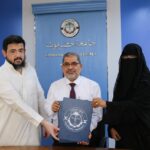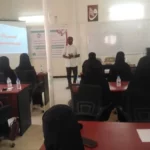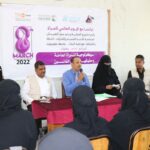Overview
Women’s Faculty was established within the framework of the Hadhramout University of Science and Technology, based on Republican Decree No. (45) for the year 1993, which stipulated the establishment of Hadhramout University of Science and Technology. Proceeding from Decree No. (18) of 1995 regarding Yemeni government universities, the establishment of the Women’s Faculty came as one of the first three faculties on which the Hadhramout University of Science and Technology was founded.
The study of the faculty began in the academic year 1996/1997 with the establishment of the Home Economics Department. The number of female students did not exceed (12) students. In 1998, the Kindergarten Department was established and the number of female students did not exceed (12). Thus, there were only 24 female students at the time, and two other scientific departments were added to the faculty in the academic year 2000/2001, including the Islamic Studies and English.
The philosophy of establishing the faculty came from the political leadership’s endeavor to absorb the largest possible number of girls towards university education. It aims to find a distinct and qualitative education that meets the desires of girls and fulfills the needs of society and the labor market in a way that serves aspects of human and economic development in Yemen.
Today, the faculty grants a bachelor’s degree in five departments: Kindergarten, Islamic Studies, English Language, Social Work and Art Education. There are more than (800) students studying in those departments.
The faculty sought towards excellence and quality through the continuous development of the study plans for the departments, which will contribute to its inclusion in the quality program, academic development and self-reliance in the future. The faculty laboratories and its physical components are currently being developed by rehabilitating the nutrition lab, the computer lab, the sewing lab, and the university kindergarten. As well as the development of the library and its contents of books and periodicals.
The faculty sought towards excellence and quality through the continuous development of the study plans for the departments, which will contribute to its inclusion in the quality program, academic development and self-reliance in the future. The faculty laboratories and their physical components are currently being developed by rehabilitating the nutrition lab, the computer lab, the sewing lab, and the university kindergarten. As well as the development of the library and its contents of books and periodicals.
In order to achieve the faculty’s goal in providing quality university education and striving for excellence. The faculty aspires to create new and modern scientific departments and specializations in the future, that meets the knowledge development standards, the needs of the labor market, and women’s civil society institutions in particular.
Vision
Mission
Objectives
- To qualify the female students scientifically, professionally and researching in a way that develops their knowledge, their personalities, and helps them to join the labor market according to their scientific specializations and professional competencies.
- Contribute to the enrollment of female students in university education in a way that increases the percentage of educated female students and serves the trends of human and economic development in Yemen.
- Contribute to human development in society through the establishment of rehabilitation courses to develop the knowledge and skills of Yemeni girls, with the support of civil society institutions.
- To strengthen the relations with relevant scientific, educational and social institutions and corresponding faculties locally and regionally in a way that enhances the academic aspects and the faculty’s outcomes quality.
- Consolidating the presence and position of the faculty in the community by adopting quality and accreditation standards that are compatible with its goals and needs.
- Seeking to achieve a community partnership with the public and private sectors to create work areas for the faculty outcomes.
- Effective use of information and communication technology in developing and raising the efficiency of institutional ability and educational effectiveness.







